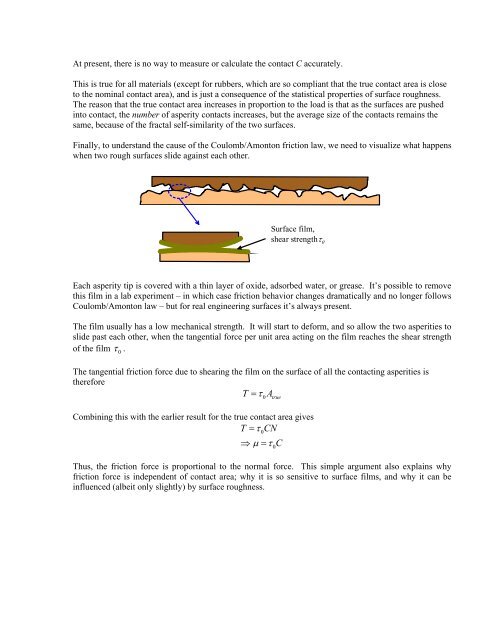Chapter 2 Review of Forces and Moments - Brown University
Chapter 2 Review of Forces and Moments - Brown University
Chapter 2 Review of Forces and Moments - Brown University
You also want an ePaper? Increase the reach of your titles
YUMPU automatically turns print PDFs into web optimized ePapers that Google loves.
At present, there is no way to measure or calculate the contact C accurately.<br />
This is true for all materials (except for rubbers, which are so compliant that the true contact area is close<br />
to the nominal contact area), <strong>and</strong> is just a consequence <strong>of</strong> the statistical properties <strong>of</strong> surface roughness.<br />
The reason that the true contact area increases in proportion to the load is that as the surfaces are pushed<br />
into contact, the number <strong>of</strong> asperity contacts increases, but the average size <strong>of</strong> the contacts remains the<br />
same, because <strong>of</strong> the fractal self-similarity <strong>of</strong> the two surfaces.<br />
Finally, to underst<strong>and</strong> the cause <strong>of</strong> the Coulomb/Amonton friction law, we need to visualize what happens<br />
when two rough surfaces slide against each other.<br />
Surface film,<br />
shear strengthτ 0<br />
Each asperity tip is covered with a thin layer <strong>of</strong> oxide, adsorbed water, or grease. It’s possible to remove<br />
this film in a lab experiment – in which case friction behavior changes dramatically <strong>and</strong> no longer follows<br />
Coulomb/Amonton law – but for real engineering surfaces it’s always present.<br />
The film usually has a low mechanical strength. It will start to deform, <strong>and</strong> so allow the two asperities to<br />
slide past each other, when the tangential force per unit area acting on the film reaches the shear strength<br />
<strong>of</strong> the film τ<br />
0<br />
.<br />
The tangential friction force due to shearing the film on the surface <strong>of</strong> all the contacting asperities is<br />
therefore<br />
T = τ A<br />
0 true<br />
Combining this with the earlier result for the true contact area gives<br />
T = τ<br />
0CN<br />
⇒ μ = τ C<br />
Thus, the friction force is proportional to the normal force. This simple argument also explains why<br />
friction force is independent <strong>of</strong> contact area; why it is so sensitive to surface films, <strong>and</strong> why it can be<br />
influenced (albeit only slightly) by surface roughness.<br />
0
















